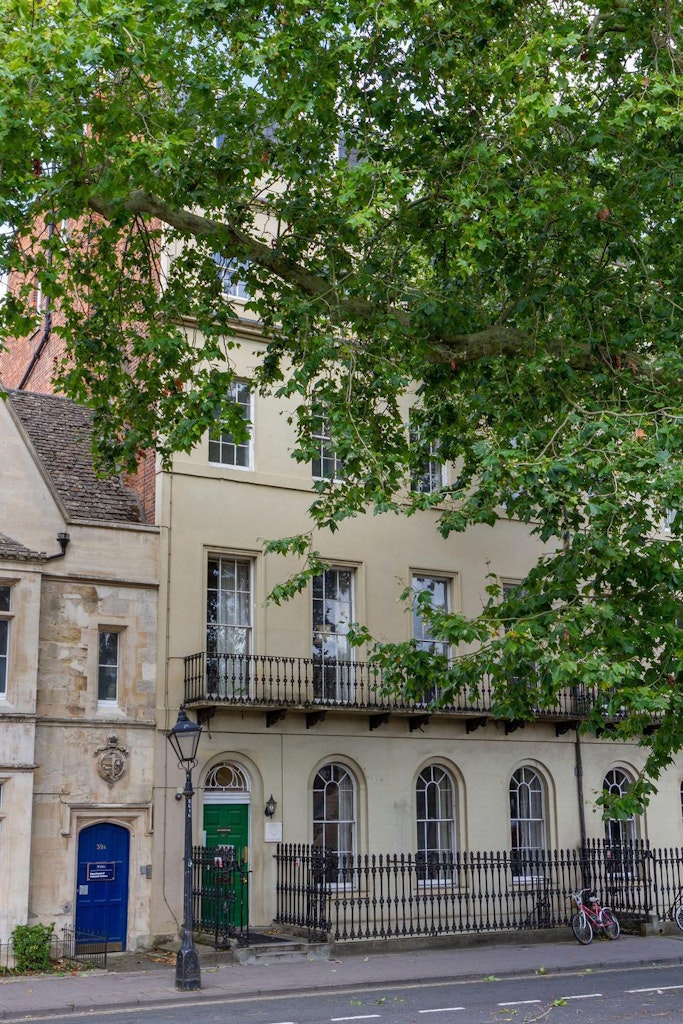How gown destroyed town
The decline and fall of the dreaming spires and their replacement by shuttered shops, sad cafés and mothballed pubs
This article is taken from the June 2023 issue of The Critic. To get the full magazine why not subscribe? Right now we’re offering five issues for just £10.
To the west of oxford, not very far from the railway station and in the oddly-named Fridesewide Square, lies a fascinating building. Dating from the Edwardian era, its primary claim to fame is that it is where the peerless Frank Cooper’s Oxford marmalade was first produced.
Subsequently, it has served as everything from an antiques market to its most recent incarnation as a bar, restaurant and arts space, bringing a touch of bohemian civilisation to a part of Oxford that often seems to have been neglected by the aesthetic. (Anyone who has shuddered and shivered through the station — a 1970s monstrosity that was revamped into a 1990s monstrosity that is now being rebuilt again — will know exactly what I mean.)
The Jam Factory, as it was appropriately known, lay about five minutes’ brisk walk from my home in West Oxford, and was my go-to spot for a final drink with friends who were visiting for the day. Until, that is, its closure, after 16 years of operation in its current form, was announced nine months ago. Yet it was always busy when I visited, thronged with everyone from intense-looking students discussing Kant and Heidegger over a vegan brunch to those attracted by its thrilling range of foreign beers. Had its owners decided to move on? Had Covid-19 done for it too?
Alas, the end of the Jam Factory lay with that most contemporary malaise: soaring rents. As an understandably downbeat statement by the organisation’s management declared, “Despite best efforts we have been unable to reach an agreement with the landlords and will close our doors for the last time on 17 September 2022. The Jam Factory is the best it has ever been. The food, art, service, plants and atmosphere are all blossoming and it is disappointing to have to walk away from this incredible venue when there is so much more to give.”
The Jam Factory’s landlord was none other than Nuffield College, an institution established by Lord Nuffield, the former motor manufacturer William Morris. His stated aim in founding the college was for it to have a more egalitarian, outward-looking attitude than many of the stuffier older institutions in the city. It specialised in the study of social sciences, was co-educational from its inception and solely consisted of graduate students, in the hope that their maturity and wisdom might give something back both to the university and to the wider city. Thanks to its founding donation by Nuffield, the college has always been wealthy (its endowment exceeds £280 million) and with only 90 students it is believed to be the richest educational institution per student in the world.
Yet, for those who are not its fellows or students, Nuffield College is more of a blight than a blessing for life in the city of Oxford. Not only content with forcing up rents for a small independent business to unsustainable levels — the college suggested in a statement that “We believe that we have done as much as we reasonably can to reach an agreement, and we are disappointed that it has not been possible to arrive at a solution and that the café has now decided not to enter into a new lease”. It also owns the vast majority of the space between the railway station and the city centre. When you arrive in Oxford by rail you are walking into town on Nuffield land.
It is, to be honest, a dispiriting way of entering what is supposed to be one of the world’s great cities. An excited first-time visitor to Oxford might expect to leave the station and be overwhelmed with panoramas of the dreaming spires, as they hope to encounter wonderful-looking shops, tempting cafés and possibly a convivial restaurant or two.
What one instead is faced with is a series of empty and abandoned shops looking desolate
What one instead is faced with is a series of empty and abandoned shops looking desolate, a few tired-looking businesses clinging on and a general air of depression and fatigue. Welcome to Oxford in 2023, it seems to say: once this city was great, and it may yet be again — Nuffield has claimed, repeatedly, to be planning ambitious regeneration plans in the grandiosely termed “West End district” — but, for the time being, it’s a hollow shell of its former glories.
If only this was an isolated case, then it would be easier to forgive, or at least ignore. There is no significant British city that does not have its neglected or down-at-heel quarters, where investment has dried up and where nobody wants to live any longer. Yet as the disappointed traveller heads further into the centre of Oxford, they might continue to feel a sense of surprise. Why are half the shops on the High Street closed down? Why are there no independent antiquarian bookshops, or indeed independent retailers for that matter? Where are the good-quality cafés and restaurants?
And why is perhaps the city’s most famous and historic pub, the Eagle and Child on St Giles, mothballed, with no signs of reopening in any form? Once, it played host to JRR Tolkien, C.S. Lewis and the Inklings: now, its only occupants, one fears, are vermin and ghosts.
If you are one of the tens of thousands of students who live in Oxford for a few years, you may care rather less about the ebb and flow of history. After all, while the city seems determined to erase much of its heritage either through design or negligence, it still boasts all the usual amenities that residents might expect. Most of the historic pubs still exist, albeit owned and operated by big breweries with the eye on profit that you might expect. (The recently reopened Lamb and Flag, now liberated from its previous owner St John’s College and run as a community-owned pub, is a pleasing, rare exception.)
You can still visit Blackwells (now a branch of Waterstones), The Randolph (an outpost of the U.S. Graduate Hotels group) or Christ Church (family ticket £56, and don’t forget to visit the gift shop). Why shouldn’t the crestfallen first-time visitor leave Oxford with a murmur of “It wasn’t what I expected it to be”?
A confession. I have skin in the game. Two decades ago, I was a student at the university. Like so many before and after me, I arrived bright-eyed and bushy-tailed, keen to study and to make my mark, in a small way, on the wider institution. I left three years later with my love of literature intact, even enhanced (albeit occasionally threatened by tutors who tried, and failed, to interest me in terrifying ideas like poststructuralism and deconstructionism), a wider knowledge of grain and grape in all their major forms and, like virtually every young man and woman who has written their Bildungsroman in the British university system, my fair share of disappointments, heartbreaks and triumphs.
I moved to London, began working as a journalist and got on with my life. But I always felt that I had unfinished business with a city that I had been visiting ever since I was a small child, and believed that, one day, I would return there, with the aim of putting down roots and raising my own family there. After all, what better place to bring up my own child than Oxford, home of imaginative storytellers from Lewis Carroll to Philip Pullman, and where virtually every street and square creaks with history?
I have now been living in Oxford once again for just over four years, and am all too aware of the old adage that “you can never go home again”. Life in the city if you are connected to the university is one thing, but to lead the life of a journalist and author in this once most bookish of cities is curiously isolating.
For a start, most writers can’t afford the ludicrously inflated house prices (on a par with the fancier parts of London per square foot, thanks to the lack of property, much of which has been acquired by the colleges to house students in) and the general cost of living here, so they have found themselves escaping to cheaper towns and cities for years now: Oxford’s loss is Norwich’s gain. The students are in the libraries, bright-eyed and studious, from the time they open, and remain in them until closing time: they eschew the pubs, with their £6.50 pints and expensive, mediocre glasses of wine.
And whose fault is this? Modernity’s? Not quite. Instead, the blame for the city of Oxford being a pale shadow of its former glories lies with the university and its colleges. As, cumulatively, by far the largest landowner in the vicinity (and probably only behind the Duke of Westminster and the Crown Estate in the country), they determine the fate of the majority of the buildings and institutions in the centre.
The rows of empty shops and sad-looking cafés, to say nothing of vast swathes of the most expensive parts of the city’s streets being turned into institutional boarding houses, are testament to a combination of greed, necessity and short-sightedness. It would no doubt delight the chancellors and administrators of the university not to be referred to as conservative (let alone Conservative), but when this sorry morass is all that is left, one wishes that this barbarism might be halted in its tracks.
Oxford was once my city and my home, but now it doesn’t feel like it belongs to anyone
In Philip Larkin’s “Poem About Oxford”, a paean to his paramour Monica Jones, Larkin muses wistfully on their separate but intertwined experiences in the “city we shared without knowing”, but, typically, reserves his contempt for “the arselicker who stays” and immerses themselves in postgraduate studies. I often wonder what Larkin would have made of that nostalgic breed, the arselicker who returns — as, indeed, he himself did on occasion, most notably to compile The Oxford Book of Twentieth Century English Verse while resident at All Souls. Larkin was one of the great poets of the impossibility of recapturing the past — “Dockery & Son”, with its reminisces of Oxford life, reeks of it — and so it is that I am increasingly waving the white flag in wan surrender.
As I write this, the London pied-a-terre is being scoped out, as the lorries full of rubble drive up and down my street at all hours of the day. Oxford was once my city and my home, but now it doesn’t feel like it belongs to anyone. The university’s international reputation remains intact, for the time being, but virtually everything else here seems in decline, even down to the increasingly undistinguished architecture that has risen. Jam tomorrow? That would be the ideal. Somehow, miserably, I am suffused with doubt.
Enjoying The Critic online? It's even better in print
Try five issues of Britain’s most civilised magazine for £10
Subscribe














